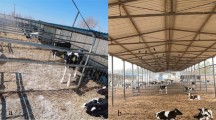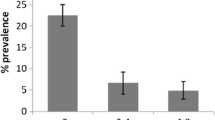Abstract
Cryptosporidium parvum is a well-known intestinal parasite which is associated with severe acute diarrhea in humans and animals. This parasite is composed of morphologically identical but genetically different multiple genotypes. In humans, cryptosporidiosis is mainly caused by two C. parvum genotypes, human genotype (previously known as genotype 1 and recently proposed as new species C. hominis) and cattle genotype (previously known as genotype 2). However, recent molecular studies indicate the genetic heterogeneity among the isolates of C. parvum human or cattle genotype. Therefore, identification of the isolates at the subgenotype level is more useful for control of the Cryptosporidium infection or for understanding of the population structure of C. parvum genotypes. In the present study, we identified the subgenotypes of the C. parvum human or cattle genotype isolates from humans and animals in Japan using DNA sequencing analysis of the C. parvum 60-kDa glycoprotein gene (GP60) and showed the new subgenotype in a raccoon dog isolate. This study suggested that C. parvum cattle genotype might be composed of zoonotic and host-specific multiple subgenotypes.
Similar content being viewed by others
Avoid common mistakes on your manuscript.
Cryptosporidium parvum is a well-known intestinal parasite, which causes an enteric disease in humans, domestic, and companion animals. This parasite is composed of morphologically identical but genetically different multiple genotypes (Xiao and Ryan 2004). In humans, cryptosporidiosis is mainly caused by two C. parvum genotypes, human genotype (previously known as genotype 1 and recently proposed as new species C. hominis) and cattle genotype (previously known as genotype 2) (Xiao and Ryan 2004). The former genotype is found almost exclusively in humans, while the latter in humans, domestic, and wild animals (Xiao and Ryan 2004), and therefore, it is speculated that Cryptosporidium infection in humans occurs by either anthroponotic (human to human) or zoonotic (animal to human) transmission.
Polymerase chain reaction-restriction fragment length polymorphism (PCR-RFLP) analysis has generally been applied for the identification of the isolates from humans and animals at the species or genotype level (Xiao et al. 1999, 2000). However, recently, DNA sequencing analysis of the C. parvum 60-kDa glycoprotein (GP60) gene had shown extensive genetic heterogeneity among C. parvum human or cattle genotype isolates and identified several subgenotypes in both genotypes (Ia, Ib, Id, Ie, If in human or IIa, IIb, IIc, IId, IIe, IIf in cattle genotype) (Peng et al. 2001; Leav et al. 2002; Alves et al. 2003; Peng et al. 2003; Sulaiman et al. 2005). Therefore, identification of the isolates at the subgenotype level is more useful for control of the Cryptosporidium infection or for understanding of the population structure of C. parvum genotypes. In the present study, we identified the subgenotypes of the C. parvum human or cattle genotype isolates from humans and animals in Japan using DNA sequencing analysis of the GP60 gene and also showed the new subgenotype in a raccoon dog isolate.
The nine isolates examined originated from the five Japanese patients, three calves, and a raccoon dog (Table 1). Cryptosporidium oocysts were purified from each sample by sucrose centrifugal flotation method (Abe et al. 2002), and the genomic DNA of each isolate was extracted and purified following the method reported previously (Abe et al. 2002). The PCR amplification of the following loci was performed using the TaKaRa Ex Taq Hot Start Version (TAKARA Shuzo, Otsu, Japan). Identification of the isolates at the species or genotype level was performed by the PCR-RFLP analyses of the small subunit ribosomal RNA (SSUrRNA) and Cryptosporidium oocyst wall protein (COWP) genes reported previously (Xiao et al. 1999, 2000). The genotype of the three isolate HNJ-1, CH-158, and CRD-154 had been identified previously (Abe et al. 2002; Matsubayashi et al. 2004; Abe et al. 2005) (Table 1). For subgenotyping analysis, GP60 gene was amplified by nested PCR with the primer sets 5′-ATA GTC TCC GCT GTA TTC-3′ and 5′-GCA GAG GAA CCA GCA TC-3′ in the primary PCR and 5′-TCC GCT GTA TTC TCA GCC-3′ and 5′-GAG ATA TAT CTT GGT GCG-3′ in the secondary PCR (Peng et al. 2001). The secondary PCR products were sequenced in both directions on an automated sequencer (ABI PRISM 310 model; Perkin-Elmer, USA), and nucleotide sequences, approximately 400 to 500 bp except forward and reverse primer regions, were aligned with available GP60 sequences from C. parvum subgenotypes reported previously using Clustal W at the DNA Data Bank of Japan (DDBJ, http://www.ddbj.nig.ac.jp/search/clustalw-j.html). Tree was constructed using the neighbor-joining algorithm based on evolutionary distances calculated by the Kimura two-parameter model with 1,000 bootstrap sampling, and was drawn using the Njplot program. The partial sequences of GP60 gene of each isolate obtained in the present study were deposited in the DNA Data Bank of Japan (DDBJ, http://www.ddbj.nig.ac.jp/) under accession numbers AB237130-AB237138.
Based on the RFLP profiles of the SSUrRNA and COWP genes, two (CH-46, 117) of the three human isolates were identified as C. parvum human genotype, while the other was human isolate (CH-146) and the three calves isolates (CC-140, 141, 153) as C. parvum cattle genotype (data not shown) (Table 1). The GP60 gene was successfully amplified in all isolates. As shown in Fig. 1, the eight isolates except the raccoon dog isolate (CRD-154) were classified into the subgenotypes reported previously (Peng et al. 2001; Leav et al. 2002; Alves et al. 2003; Peng et al. 2003; Sulaiman et al. 2005). Namely, the five isolates, HNJ-1, CH-146, CC-140, 141, 153, from humans and calves identified as cattle genotype were classified into IIa or IIc, and the three isolates CH-46, 117, and 158 from humans identified as human genotype were into Ie, Ia, and Ib, respectively. On the other hand, the raccoon dog isolate (CRD-154) identified as cattle genotype was not classified into any subgenotypes and appeared to be new subgenotype (Fig. 1). At present, in Japan, two subgenotypes, Ia and Ie, have been found in human isolates (isolates HJ3 and HJ2 in Fig. 1) (Wu et al. 2003), and in the present study, we showed the presence of other subgenotypes in Japanese human and animal isolates.
Phylogenetic relationships of the isolates from humans and animals examined in the present study to multiple subgenotypes in Cryptosporidium parvum human and cattle genotypes as inferred by neighbor-joining analysis, based on the nucleotide sequences of GP60 gene. Original hosts, localities, and accession numbers in GenBank are shown in parentheses after the names of the isolates. The bootstrap proportions (%) greater than 50% are shown at each branch except the very shorts ones within each subgenotype. The isolates examined in the present study are in boldfaced
In Portugal, 41 isolates from domestic and wild ruminants were subgenotyped and were classified into only two subgenotypes, IIa or IId (Alves et al. 2003). The three isolates from calves examined in the present study were also identified as IIa. Although the data about the molecular typing at subgenotype level of the cattle genotype isolates from animals are limited in the world, only IIa and IId among six subgenotypes of cattle genotype appeared to be zoonotic and the other subgenotypes (IIb, IIc, IIe, IIf) might be human-specific. Previously, we showed for the first time the presence of the C. parvum cattle genotype in wild mammals (raccoon dog) and suggested that the isolates from wild mammals might have the zoonotic potential. However, in the present study, this isolate (CRD-154) from raccoon dog was not classified into any subgenotypes (Fig. 1), and therefore, we speculate that C. parvum cattle genotype might be composed of zoonotic and host-specific multiple subgenotypes. Further molecular epidemiological studies including the typing at the subgenotype level is required to clarify the zoonotic potential and host specificity of the subgenotypes in C. parvum cattle genotype.
References
Abe N, Kimata I, Iseki M (2002) Identification of genotypes of Cryptosporidium parvum isolates from a patient and a dog in Japan. J Vet Med Sci 64:165–168
Abe N, Nakamura S, Kimata I (2005) An imported case of mixed infection by Giardia and Cryptosporidium parasites in Japan. Seikatsu Eisei 49:48–51
Alves M, Xiao L, Sulaiman I, Lal AA, Matos O, Antunes F (2003) Subgenotype analysis of Cryptosporidium isolates from humans, cattle, and zoo ruminants in Portugal. J Clin Microbiol 41:2744–2747
Leav BA, Mackay MR, Anyanwu A, O’Connor RM, Cevallos AM, Kindra G, Rollins NC, Bennish ML, Nelson RG, Ward HD (2002) Analysis of sequence diversity at the highly polymorphic Cpgp40/15 locus among Cryptosporidium isolates from human immunodeficiency virus-infected children in South Africa. Infect Immun 70:3881–3890
Matsubayashi M, Abe N, Takami K, Kimata I, Iseki M, Nakanishi T, Tani H, Sasai K, Baba E (2004) First record of Cryptosporidium infection in a raccoon dog (Nyctereutes procyonoides viverrinus). Vet Parasitol 120:171–175
Peng M, Matos O, Gatei W, Das P, Stantic-Pavlinic M, Bern C, Sulaiman IM, Glaberman S, Lal AA, Xiao L (2001) A comparison of Cryptosporidium subgenotypes from several geographic regions. J Eukaryot Microbiol 2001 (Suppl.):28S–31S
Peng MM, Meshnick SR, Cunliffe NA, Thindwa BDM, Hart CA, Broadhead RL, Xiao L (2003) Molecular epidemiology of cryptosporidiosis in children in Malawi. J Eukaryot Microbiol 50:557–559
Sulaiman IM, Hira PR, Zhou L, Al-Ali FM, Al-Shelahi FA, Shweiki HM, Iqbal J, Khalid N, Xiao L (2005) Unique endemicity of cryptosporidiosis in children in Kuwait. J Clin Microbiol 43:2805–2809
Wu Z, Nagano I, Boonmars T, Nakada T, Takahashi Y (2003) Intraspecies polymorphism of Cryptosporidium parvum revealed by PCR-restriction fragment length polymorphism (RFLP) and RFLP-single-strand conformational polymorphism analyses. Appl Environ Microbiol 69:4720–4726
Xiao L, Morgan UM, Limor J, Escalante A, Arrowood M, Shulaw W, Thompson RC, Fayer R, Lal AA (1999) Genetic diversity within Cryptosporidium parvum and related Cryptosporidium species. Appl Environ Microbiol 65:3386–3391
Xiao L, Limor J, Morgan UM, Sulaiman IM, Thompson RC, Lal AA (2000) Sequence differences in the diagnostic target region of the oocyst wall protein gene of Cryptosporidium parasites. Appl Environ Microbiol 66:5499–5502
Xiao L, Ryan UM (2004) Cryptosporidiosis: an update in molecular epidemiology. Curr Opin Infect Dis 17:483–490
Author information
Authors and Affiliations
Corresponding author
Rights and permissions
About this article
Cite this article
Abe, N., Matsubayashi, M., Kimata, I. et al. Subgenotype analysis of Cryptosporidium parvum isolates from humans and animals in Japan using the 60-kDa glycoprotein gene sequences. Parasitol Res 99, 303–305 (2006). https://doi.org/10.1007/s00436-006-0140-0
Received:
Accepted:
Published:
Issue Date:
DOI: https://doi.org/10.1007/s00436-006-0140-0





